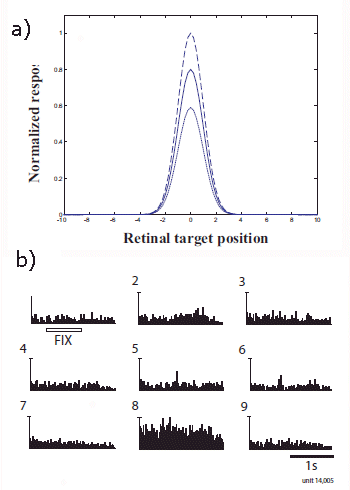Breaking news
[Back to archive]
The latest results achieved by the project consortium.
Evidence for Peak-shaped Gaze Fields in Area V6A: Implications for Sensorimotor Transformations in Reaching Tasks

Fig 1: a) Gain modulation of the sensory cell. The three curves correspond to different gaze directions: 0° (solid line), -23° (longdashed line), and 23° (dotted line). b) Eye position-related activity of one V6A cell tested in nine gaze directions and showing a non-planar tuning.
Most of the literature studies have shown that the direction of gaze can modulate the gain of neuronal responses in parietal cortical areas. These “gain fields” may be important for converting visual representations from retinotopic to head-centered coordinates. In this work we studied the gaze-dependent modulations of the ongoing activity of cells of the parietal area V6A, an area involved in visuomotor transformation for prehension acts. In particular, we investigated if the tuning of these gaze-related cells is linear or peak-shaped, and we assessed how a model based on peak-shaped gaze modulations can show good performances in localizing targets in space.
In area V6A there are different kinds of gaze modulations: there are cells whose activity is linearly modulated by gaze position, but they are a minority in our cell population. The overhealming majority (73%) of V6A gaze-related cells show a non-linear, peak-shaped behavior, like the one shown in figure 1A.
This cell discharged vigorously when the animal was fixating in the bottom-central part of the visual space in darkness, so the gaze field of this cell was clearly peak-shaped, with the peak of activity in the lower, central part of the animal’s field of view.
The reported experimental observations for area V6A support the computational theory of the gain fields to produce a distributed representation of the real position of targets in head-centered coordinates. Although it was originally pointed out that the majority of the cells exhibit roughly linear spatial gain fields (Andersen, R., Mountcastle, V. J. Neuroscience 3, 532–548 (1983); Andersen, R., Essick, G., Siegel, R. Science 230, 456–458 (1985), we have verified that the peak-shaped gaze fields reported in this study are not in contrast with the gain field models developed
in the theoretical neuroscience literature. On the contrary, the use of peak-shaped (e.g., non monotonic) gaze fields even improves the efficiency of the coding scheme by reducing the number of units that are necessary to encode the target position.
To analyze the effect of the gaze field on the representation capability of the neural population, we referred to the model of Salinas and Abbott (PNAS 93, 11956-11961 (1996). We compared the results obtained by using peak-shaped gaze fields in the modulations, explicitly. Fig. 1B shows the resulting population response of the cells for three different gaze angles. From a computational point of view, the analysis of gain modulation with peaked-shaped functions evidenced advantages in terms of the efficacy and efficiency of the representation of the target location when a limited number of units are considered.
Breveglieri, R.(1), Bosco, A.(1), Canessa, A.(2), Fattori, P.(1), Sabatini, S.P.(2)
Department of Human and General Physiology (1)
Department of Biophysical and Electronic Engineering (DIBE) (2)
|